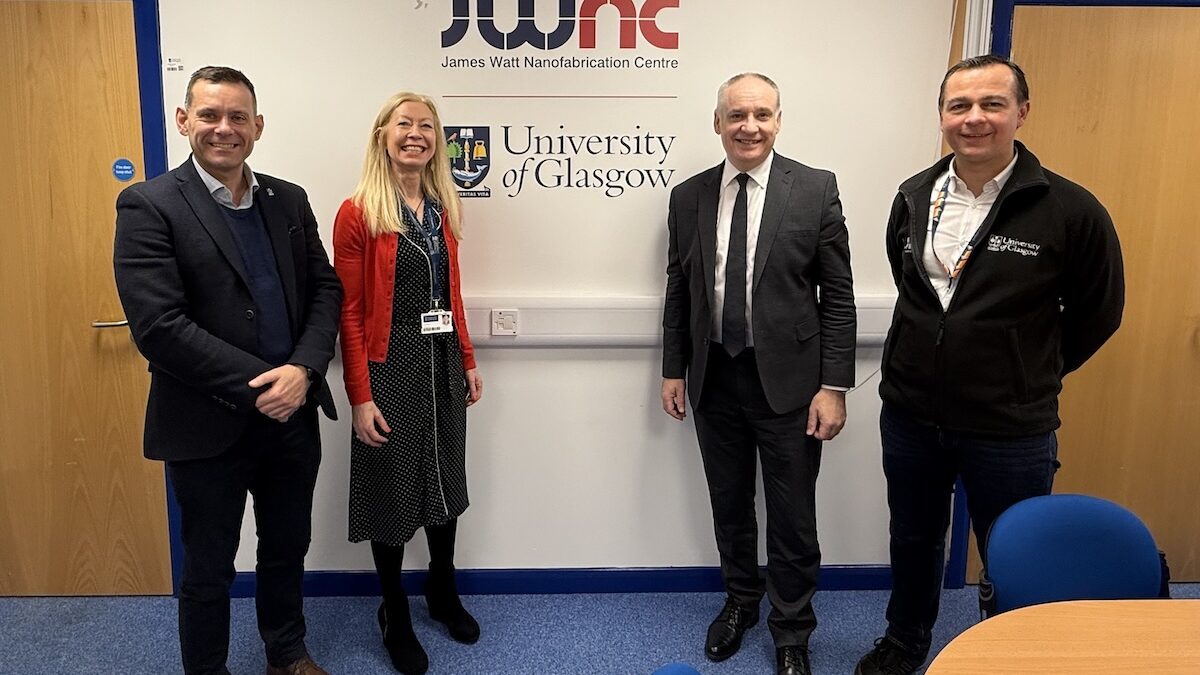Scotland’s business minister has visited a cutting-edge research facility powering next generation technologies at the University of Glasgow.
Richard Lochhead met with staff at the James Watt Nanofabrication Centre three weeks after announcing the formation of Scotland’s ‘critical technologies supercluster’.
The supercluster, which the University of Glasgow played a leading role in establishing, will work with academic and industry partners to support development of emerging fields including photonics, quantum, semiconductors, connectivity and sensing.
The technologies are projected to create an additional 7,000 jobs in the country’s high-tech industries, helping the sector’s value grow to more than £10 billion by 2035.
The JWNC, one of the UK’s leading facilities for turning fundamental science into components for cutting-edge devices and technologies used by global tech companies, is at the heart of the Supercluster’s plans.
Mr Lochhead was given a tour of the JWNC’s facilities by the centre’s director, Professor Martin Weides, and Evelyn Toma, the Centre’s director of strategy. He heard how the centre’s £35 million state-of-the-art facilities, which are made available to industry through Kelvin Nanotechnology Ltd, are being used by researchers and global industries to develop next-generation electronic, photonic, quantum and bio-compatible devices.
These technologies could find future applications in areas including life-saving wearable diagnostics, satellite-independent navigation systems, and renewable energy solutions.
He said: “The James Watt Nanofabrication Centre is developing the next generation of critical technologies to power smartphones and cars as well as enable new space exploration technology, artificial intelligence and offshore power.
“As our Innovation Strategy and Programme for Government set out, we are working to position Scotland as one of the most innovative small countries in the world. This includes collaborating with industry, academia and our enterprise agencies to capitalise on Scotland’s existing strengths to drive economic growth.”
Professor Weides added: “We were delighted to host Mr Lochhead at the James Watt Nanofabrication Centre today to demonstrate how the University of Glasgow’s world-class facilities are supporting the research and development of technologies which will help drive Scotland’s cutting-edge economy in the years to come.
“The university’s researchers work with partners around the world to make fundamental science breakthroughs and take them to market, creating real impact through initiatives like the Critical Technologies Accelerator, funded by £3.4 million from the UK Government’s Innovation Accelerator programme. This visit was a great opportunity to highlight the vital role that university-driven research and innovation will play in Scotland’s future prosperity.”
Mr Lochhead also spoke with Professor Chris Pearce, the university’s vice principal (Research and Knowledge Exchange) about plans for the possibility of expanding the JWNC’s facilities in the future, before meeting principal and vice-chancellor, Professor Sir Anton Muscatelli.
Professor Sir Anton said: “The minister’s visit comes at an exciting time for the University of Glasgow as we continue to expand our innovation capabilities with our ongoing £1.3 billion campus redevelopment programme and deepen our industry collaborations through the Glasgow Riverside Innovation District, in partnership with Scottish Enterprise and Glasgow City Council.
“Universities are powerful catalysts for increasing productivity and driving economic growth when they work closely with government and industry. Scotland’s central belt is home to a unique concentration of expertise in cutting-edge technology which the formation of Scotland’s Critical Technologies Supercluster will help to reach its full potential. Investing in expansion of the JWNC into new facilities will help to support the Supercluster’s aims, enabling significant new developments in critical areas like quantum technologies, photonics and semiconductors.“




